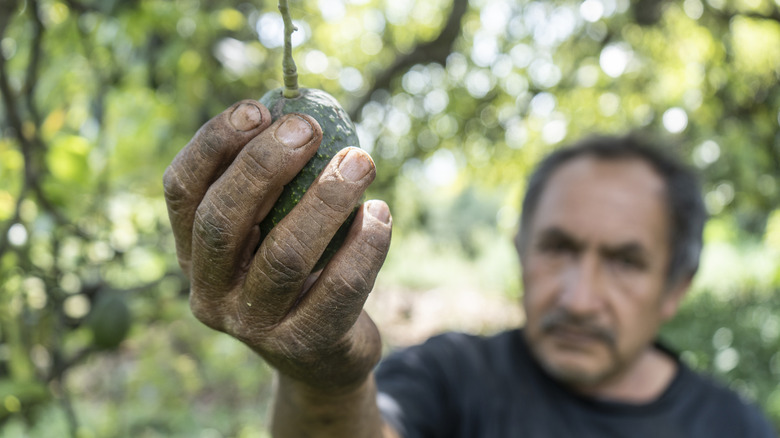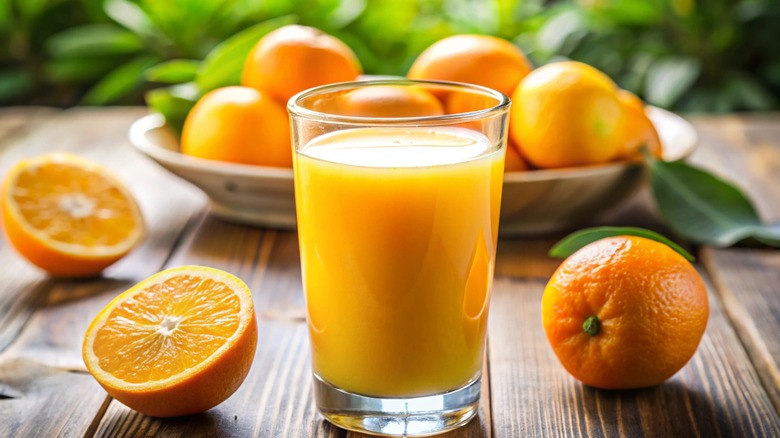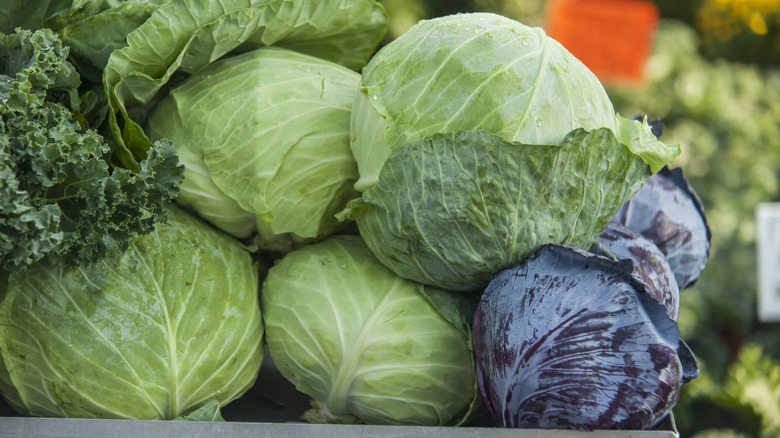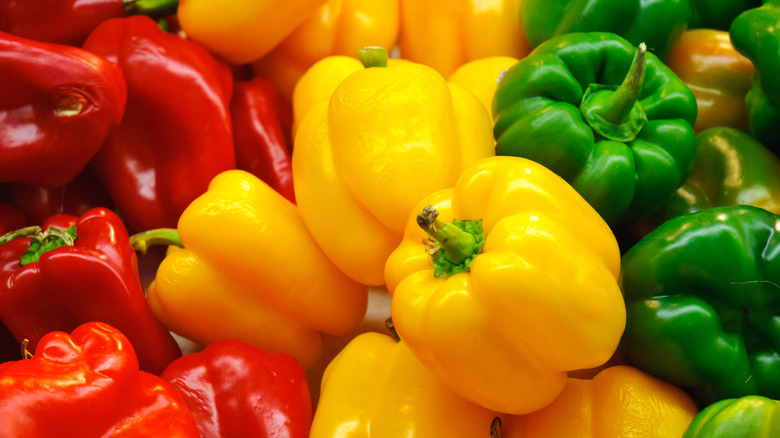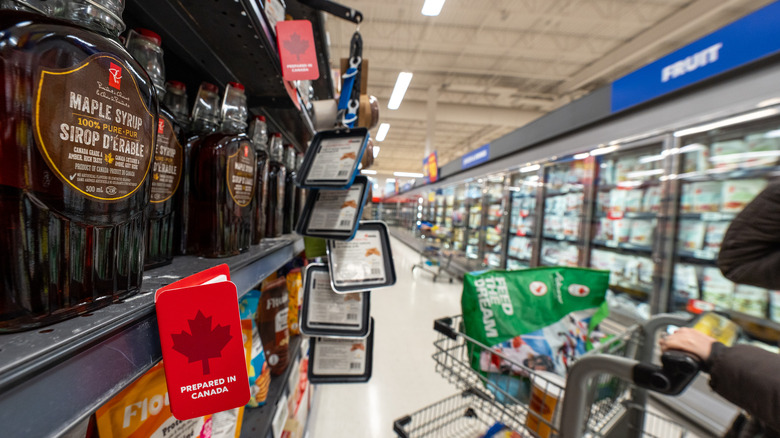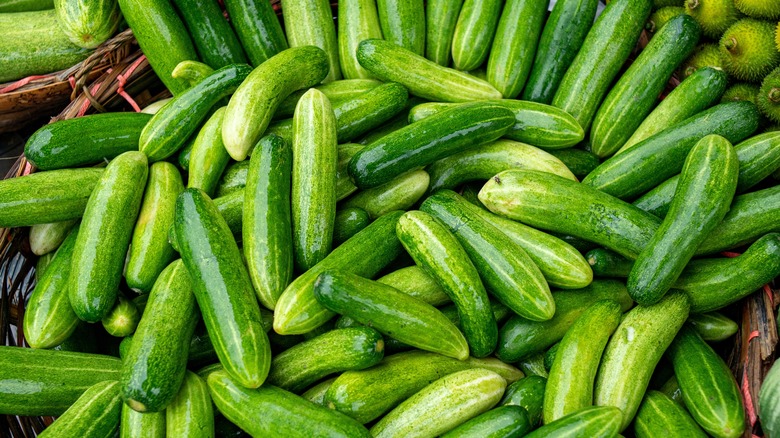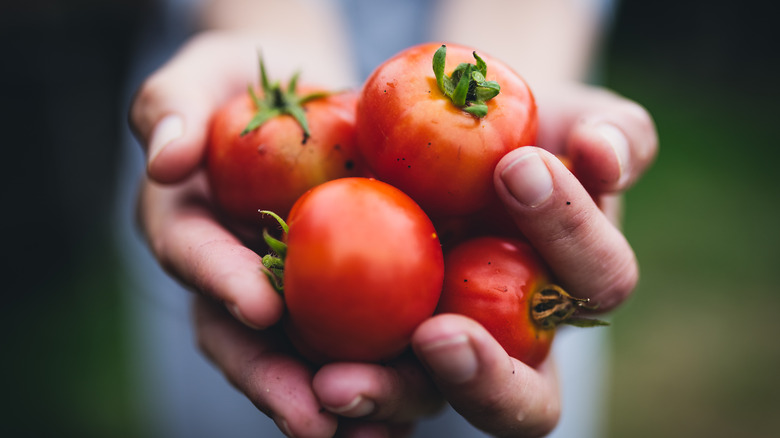12 Groceries That Could Skyrocket In Price In April
The federal government's tariff policies have experienced something of a rocky start. Originally set to take effect on February 4, 2025, elements of the added import duty have been scuttled, delayed, or reconfigured in the months since. New details are planned for release into the government's tariff strategy on April 2nd, and all manner of approaches have seemingly been explored. There's talk of a "two-step" tariff program, while a rate of up to 50% on imports from trading partners across the board has also seeped out into the media.
Regardless of how these plans ultimately take shape, it's likely that imports coming from three nations in particular will see their prices rise for consumers when tariffs eventually do take effect. Canada, China, and Mexico have consistently been at the forefront of the administration's ire when it comes to trade. In all of the back and forth over how to enact the tariffs it wants to impose, the government has never wavered on what might be considered the primary target of the additional import duties. These three countries remain at the head of the pack here, and consumers may be in for quite the sticker shock when the calendar flips over to April if the government's tariffs do kick into gear as anticipated. Unfortunately for consumer budgets, this trio of trading partners accounted for 45% of all imports to the United States in 2022, and claim the top three spots individually for both imports and exports. Retaliatory tariffs and skyrocketing grocery store pricing may be in the cards, and these staples in particular are most likely to see the effects.
Avocados
Avocados shouldn't be a surprise and therefore offer themselves as a great starting point. Roughly 90% of the avocados consumed in America are imported. Two decades ago the majority of the American avocado supply was homegrown — particularly in California – but a rapidly increasing demand for the fruit in the years since has led to a steep increase in sourcing from abroad. There just isn't enough usable landscape in Southern California and elsewhere to support the explosive growth in demand for this superfood produce alongside other growing needs. As a result, Mexico has found itself increasingly thrust into the spotlight when it comes to avocado cultivation. The country is the world's top producer of avocados, and perhaps unsurprisingly the United States is Mexico's most lucrative trading partner in this area. Of the enormous volume of avocado imports the United States requires, 88% all of it comes from this southern neighbor.
Avocados can be found in all kinds of modern culinary staples, and so this isn't just bad news for the stereotypical avocado toast eater. Avocados feature prominently in contemporary sushi dishes, and they play a key role in all manner of sandwiches, salads, and other light and healthy menu items. Avocados naturally find themselves in Mexican and Tex-Mex dishes, as well. So consumers should expect to see a jump in prices across the board from guacamole to sushi and beyond.
Orange juice
Orange juice Is consistently thought of as a product primarily sourced in Florida. 20 years ago this was the case, although an increase in orange production across the country has been steadily decreasing the impact of Florida oranges on the market as a whole. Today, almost 80% of orange juice that consumers will find on the shelves comes from abroad. The vast majority starts its journey to American shows on farms in Mexico (67% of all OJ imports to the U.S.).
In much the same way that American breakfasts stand to be impacted significantly by a change in the way import pricing affects avocados, this essential product is a complicated and significant element in the contemporary market. Orange juice isn't just a completed product, though. It also features as a critical ingredient in smoothies, breakfast bowls, and even alcoholic cocktails. As is the case with many other fruit and vegetable products, a hike in orange juice prices will affect a variety of other areas. Moreover, even though oranges are grown in abundance in the United States, the reliance on increased imports of oranges and orange juice have given growers the ability to focus their resources on other products that may be even more lucrative. Making a turn back toward orange production isn't possible with a flip of the switch and so a new normal in this part of the market may be imminent.
Sweet corn
Sweet corn is the variety of this staple crop that humans like to eat. American farmers produce a truly enormous amount of corn — the United States is the largest global producer, consumer, and exporter of the crop as a whole (planting about 90 million acres annually). But that's not the whole story. 99% of the corn grown in the U.S. is known as dent corn or field corn; this isn't the product you find in the grocery store. Field corn is a raw material used in the production of other goods. Through the magic of manufacturing science, field corn is transformed into ethanol, raw plastic material, and much more. It's also used overwhelmingly as a feeding resource for livestock across the country (and beyond as an export crop).
With so much of American farm resources dedicated to growing a variety of corn that humans don't eat, it shouldn't come as a surprise that the corn you buy in the store comes from somewhere else. In recent years, almost 94% of imported sweet corn that consumers have had access to has been from Mexico. Sticking with the theme of unsurprising revelations, Canada delivers almost the entire remainder of the United states is import volume of sweet corn (the rest has been sourced from Guatemala). Whether you're a fresh sweet corn purchaser or someone who prefers bagged and frozen corn for your meals, when tariffs take effect you can expect this product to jump in price, too.
Strawberries
Mexico was responsible for roughly 85% of all American strawberry imports in 2022, with the total import value of fresh and frozen strawberries combined reaching $1.2 billion that year. In 2023 those figures were even greater: American growers exported just fresh strawberries to the tune of $553 million while the marketplace took in $1.18 billion, with over 97% coming from Mexico.
Imports aren't the only source of strain when it comes to the price of strawberries. The berry features a labor-intensive picking process and a downturn in the number of field workers to perform seasonal harvest tasks is predicted heading into the future. A smaller labor force as a result of other policy objectives from the administration will likely see strawberry prices rise across the board. Coming off the heels of an unholy balance between higher harvest costs with replacement farmhands and lower total output on the other hand, the price of imported and homegrown strawberries will each be driven higher in the coming weeks and months.
Cabbage
The United States imports almost three times as much cabbage as it exports, based on figures from recent years. Essentially all cabbage imports come from either Mexico or Canada at nearly a 50/50 split (with a bit more from the south than the north). As is the case with many other critical vegetables, cabbage is a staple ingredient in cuisine from all around the world. Asian dishes, hearty European meals, and even salads and other vegetable-focused inclusions on a typical menu requires the use of cabbage to complete them. Whether you're sitting in a deli or exploring Asian fusion flavors at PF Chang's, cabbage is a part of the standard fare.
Many of the fruits and vegetables that feature on this list act as a kind of compliment in dishes. Green leafy vegetables (which some Americans have focused on growing at home) are a different kind of produce, however. In a food environment that is already prioritizing fast meals and often less than healthy concoctions, a lack of cheaply available vegetables such as cabbage or lettuce (which is also imports in great numbers) will only serve to promote an increase in Americans' turn toward unhealthy dietary norms.
Peppers
Both hot peppers and bell peppers alike are imported in significant volumes from Mexico. Naturally, pepper variants like jalapeños and poblanos originate from the country. But in the modern marketplace, a wide range of Peppers from across the spectrum are grown in Mexico specifically as a cash crop bound for export. Roughly 76% of bell peppers sold in the United States begin their journey to the table sprouting from Mexican soil. These peppers in particular serve as a critical ingredient in a wide variety of local and international cuisine staples. Chinese dishes, Mexican fajitas, and Italian sauces all frequently feature this versatile vegetable.
As a result, you can expect your grocery bill to balloon at least a bit if you are a home cook who frequently works with bell and other pepper products when feeding your family. Similarly, meals out at restaurants will be affected by the trading relationship between the United States and Mexico across virtually all menu types and cuisine inspirations. Japanese steakhouses, Chinese takeout restaurants, Indian curry joints, and traditional American restaurants like Chili's and Applebee's will all feel the effects of increased prices in this arena with particular focus on the humble bell pepper.
Maple syrup
Maple syrup is not exclusive to Canada, but it certainly feels that way when looking at a bottle of this stuff. Most Maple syrup products feature a Canadian maple leaf prominently emblazoned on the logo, or at least some other clear symbology that the product in your hand was drained from a Canadian Maple tree. The United states produces Maple syrup as well, but 71% of global supply comes from Canada. More to the point, 62.1% of all Canadian Maple syrup exported to the world was delivered to the American consumer marketplace.
In 2021, there were over 6,000 maple farms in Canada, with the vast majority in Quebec — ideally positioned for bottling and shipping on a short trip South to eager U.S. mouths. Maple syrup is already a contentious product, with a unique history of hijinks and heists, and a quirky but deadly serious "cartel" operating within its nexus. Considering the retaliatory tariffs that the Canadian government has already begun to plan and talk about, an already costly product is almost certainly going to get more expensive in the coming weeks. A trade war starting to heat up between these two North American neighbors is only going to make the market more complex.
Cucumbers (and by extension pickles)
A vegetable that isn't at the forefront of most eaters' minds, the cucumber is one grocery item that will see its price suddenly increased with the introduction of new tariffs on imports from the United States' major trading partners. Only 11% of cucumbers consumed in the U.S. are grown locally. 88% of the market's supply comes from Mexico, Canada, or China (with an additional 1% sourced elsewhere). Cucumbers may not be all that important in most dishes, acting as a sauce supplement in Greek cuisine and fading into the background in others. However, cucumbers are essential in creating another product that Americans do use in great abundance.
Whether as a relish element or a direct topping for sandwiches and other bun-enhanced American icons (the ballpark hotdog or mighty hamburger, for instance), the pickle is a well established essential in many American food experiences. However, pickles are made from cucumbers. Adding tariffs to the import of cucumbers into the United States will by extension increase the cost of pickle production (whether transformed in brine within the confines of the U.S. or prior to import).
Fresh tomatoes
Tomatoes are a massively important component in all corners of the culinary universe. From Indian curries to Italian sauces and Latin American dips, tomatoes act as the base of a huge variety of recipes. Those looking to deliver home recipes to their own table across the spectrum of kitchen creations may find a slightly easier road ahead than others. However, there remain a number of use cases in which canned tomatoes — which the United States is a net exporter of — just won't cut it. Similarly, anytime you go out to eat at a restaurant with even a remotely upscale menu you'll likely be looking at a price increase as a result of the necessity in using fresh tomatoes as an ingredient rather than cheaper, canned tomatoes.
Indeed, almost 4 billion pounds of fresh tomatoes were imported by U.S. buyers between January and October of 2023. It likely comes as no surprise that 90% of this fresh produce came from Mexico. The reality is that Mexico is a country that also enjoys a significantly diverse range of climate conditions. This large country in Central America plays a critically important role in all manner of fruit and vegetable import to the U.S. because of this wide climactic diversity and its favorable location just to the south. Just about anything that grows in the U.S. can also be found thriving in Mexico, and so plenty of staple products, such as fresh tomatoes, have been grown in abundance for the U.S. import market specifically, for many years.
Clothing items
Moving away from pantry items, plenty of other typical purchases you'll find in the grocery store or in expanded supermarkets like Walmart or Costco will also see their pricing impacted substantially by new tariffs. Americans buy an average of 68 new clothing items each year, and with 50% of the shoes American wear and roughly 30% of the market's clothing coming from China, there will be a major price increase tacked onto these important purchases in the event of a new tariff being levied.
Your own personal shopping habits may include staple items like socks and underwear or even apparel like undershirts or exercise clothing on the same list as your grocery shopping. If you buy these kinds of extra-consumable clothing items at the same place you do your grocery shopping, you can expect a perhaps surprising addition to your routine grocery costs in the coming months. As a practical matter, these kinds of goods are likely to either be sourced from another manufacturing center in a different (still foreign) country, or remain imported from the same source with the addition of new tax implications. Keeping import channels stable will obviously increase the price directly, but making a switch isn't guaranteed to lower it or even keep costs the same. Moving production is expensive all on its own, and making a switch comes with other potential tax liabilities (especially if blanket tariffs are implemented) and a different cost basis for producing and shipping these goods.
Prescription and over the counter medication
Medication is another crucial area in which consumers will see expanded grocery prices. Across the board, a huge range of critical health care products come from abroad. Significant manufacturing resources for the pharmaceutical and health industries are found in Mexico. Companies like Johnson & Johnson, GE Healthcare, and Welch Allyn all produce a significant amount of their goods for the wider North American market in Mexico. From gauze and gurneys to pacemakers and MRI machines, Mexican manufacturing offers a critical support system for the American health care landscape.
Returning to the shelves, however, the prevalence of generic drugs in the U.S. buyer's mindset is where things get dire. Prescription medication is set to be intimately affected by tariffs, too. 91% of American prescriptions were filled with generic drugs rather than a name brand alternative in 2022. This helps buyers keep costs low, a frugal move that can really help balance the budget. But changes in tariff policy, specifically those that affect imports from China, may just upend this critical resource. Chinese manufacturers combine to make the country the United States' most important trading partner when it comes to pharmaceutical goods. Specifically, China is one of the largest suppliers of generic medication to the U.S. marketplace. As is the case with many other goods that Americans use in large quantities, simply shifting production to somewhere else isn't exactly feasible, and so consumers should anticipate that any low cost drugs they use will start to become more expensive with the introduction of new taxation norms.
Tequila
*Finally, all tequila consumed in the United States is imported from Mexico. This means that cocktails featuring the agave-forward nectar as well as the bottles themselves may see their price skyrocket in the coming months. "Tequila" isn't just a drink, however. Much like protected designation of origin products from Europe (think "Champagne" or "Manchego,") tequila is made only with blue Weber agave grown in a few regions of central Mexico, with Jalisco being the most prominent among them. This means that while agave plants might be able to grow decently or even equally well in desert regions of say Arizona or California, the resulting alcoholic distillation would not be tequila. Instead, distillers might successfully deliver a tequila-inspired drink (the sparkling wine to Champagne's "Champagne"). Moreover, it's well-documented that in the same way French terroir characterizes so much of what gives a wine its individualism, so too is the spirit of any particular tequila grounded in the Earth its agave leaves are harvested from.
Tequila is a quintessentially Mexican drink, and its designation is protected across North America by the NAFTA agreement and in roughly 40 other countries around the world by similar trade compacts. Anyone hoping to get their hands on a bottle to make margaritas at home or seeking the particular party atmosphere that tequila shots and cocktails bring to the table out at a bar or restaurant should anticipate a more expensive evening come April.

